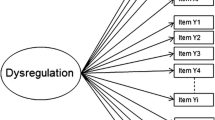Abstract
Withdrawn/depressed behavior (WD) as defined by the Child Behavior Checklist (CBCL) relates to various outcomes in developmental psychopathology such as depression, pervasive developmental disorders, and suicide. We sought to examine the temperamental characteristics of children who concurrently endorse symptoms of WD. Junior Temperament and Characteristic Inventory (JTCI) and CBCL data were collected from 397 children’s parents in a family study in the northeastern United States. Linear mixed models were used to test the relations between WD and temperament dimensions (Novelty Seeking, Harm Avoidance, Reward Dependence, Persistence) on the JTCI, while controlling for age, sex, item overlap, and co-occurring aggression and attention problems. When controlling for definitional artifact and CBCL aggressive behavior and attention scores, high harm avoidance and low reward dependence were both significant predictors of childhood withdrawn behavior. This study marks the first characterization of a temperamental profile associated with WD in children and adolescents.

Similar content being viewed by others
References
De Groot A, Koot HM, Verhulst FC (1994) Cross-cultural generalizability of the Child Behavior Checklist cross-informant syndromes. Psychol Assess 6(3):225–230
Rubin DH, Althoff RR, Walkup JT, Hudziak JJ (2013) Cross-informant agreement on child and adolescent withdrawn behavior: a latent class approach. Child Psychiatry Hum Dev 44(3):361–369
Heubeck BG (2000) Cross-cultural generalizability of CBCL syndromes across three continents: from the USA and Holland to Australia. J Abnorm Child Psychol 28(5):439–450
Hofstra MB, Van der Ende J, Verhulst FC (2000) Continuity and change of psychopathology from childhood into adulthood: a 14-year follow-up study. J Am Acad Child Adolesc Psychiatry 39(7):850–858
Ferdinand RF, Verhulst FC (1995) Psychopathology from adolescence into young adulthood: an 8-year follow-up study. Am J Psychiatry 152(11):1586–1594
Kasius MC, Ferdinand RF, van den Berg H, Verhulst FC (1997) Associations between different diagnostic approaches for child and adolescent psychopathology. J Child Psychol Psychiatry 38(6):625–632
Aschenbrand SG, Angelosante AG, Kendall PC (2005) Discriminant validity and clinical utility of the CBCL with anxiety-disordered youth. J Clin Child Psychol 34(4):735–746
Miller PM, Byrne M, Hodges A, Lawrie SM, Johnstone EC (2002) Childhood behaviour, psychotic symptoms and psychosis onset in young people at high risk of schizophrenia: early findings from the edinburgh high risk study. Psychol Med 32(1):173–179
Ooj YP, Rescorla L, Ang RP, Woo B, Fung DS (2011) Identification of autism spectrum disorders using the child behavior checklist in Singapore. J Autism Dev Disord 41(9):1147–1156
Goldsmith HH, Buss AH, Plomin R, Rothbart MK, Thomas A, Chess S et al (1987) Roundtable: what is temperament? Four approaches. Child Dev 58(2):505–529
Laceulle OM, Ormel J, Vollebergh WA, Van Aken MA, Nederhof E (2014) A test of the vulnerability model: temperament and temperament change as predictors of future mental disorders—the TRAILS study. J Child Psychol Psychiatry 55(3):227–236
Kagan J, Reznick JS, Snidman N (1988) Biological bases of childhood shyness. Science 240(4849):167–171
Affrunti NW, Woodruff-Borden J (2015) Negative affect and child internalizing symptoms: the mediating role of perfectionism. Child Psychiatry Hum Dev. doi:10.1007/s10578-015-0571-x
Gulley LD, Hankin BL, Young JF (2015) Risk for depression and anxiety in youth: the interaction between negative affectivity, effortful control, and stressors. J Abnorm Child Psychol. doi:10.1007/s10802-015-9997-7
Cloninger TL, Przybeck TR, Syarik DM, Wetzel RD (1994) The temperament and character inventory: a guide to its development and use. Washington University, St. Louis
Luby JL, Svrakic DM, McCallum K, Przybeck TR, Cloninger CR (1999) The Junior Temperament and Character Inventory: preliminary validation of a child self-report measure. Psychol Rep 84(3 Pt 2):1127–1138
Pitzer M, Esser G, Schmidt MH, Laucht M (2010) Early predictors of antisocial developmental pathways among boys and girls. Acta Psychiatra Scand 121(1):52–64
Baer J, Shreck M, Althoff RR, Rettew D, Harder V, Ayer L et al (2014) Child temperament, maternal parenting behavior, and child social functioning. J Child Fam Stud 24(4):1152–1162
Rettew DC, Althoff RR, Dumenci L, Ayer L, Hudziak JJ (2008) Latent profiles of temperament and their relations to psychopathology and wellness. J Am Acad Child Adolesc Psychiatry 47(3):273–281
Kim SJ, Lee SJ, Yune SK, Sung YH, Bae SC, Chung A et al (2006) The relationship between the biogenetic temperament and character and psychopathology in adolescents. Psychopathology 39(2):80–86
Achenbach TM (1991) Manual for the child behavior checklist/4-18. Department of Psychiatry, University of Vermont, Burlington
Cloninger CR, Svrakic DM, Przybeck TR (1993) A psychobiological model of temperament and character. Arch Gen Psychiatry 50(12):975–990
Tabachnick BG, Fidell LS (1996) Using multivariate statistics, 3rd edn. HarperCollins Publishers, New York
Lyoo IK, Han CH, Lee SJ, Yune SK, Ha JH, Chung SJ et al (2004) The reliability and validity of the junior temperament and character inventory. Compr Psychiatry 45(2):121–128
Klein DN, Dyson MW, Kujawa AJ, Kotov R (2012) Temperament and internalizing disorders. In: Zentner M, Shiner R (eds) Handbook of temperament. Guilford Press, New York, pp 541–561
Thomas A, Chess S (1977) Temperament and development. Brunner/Mazel, New York
Hoekstra RA, Bartels M, Hudziak JJ, Van Beijsterveldt TC, Boomsma DI (2008) Genetic and environmental influences on the stability of withdrawn behavior in children: a longitudinal, multi-informant twin study. Behav Genet 38(5):447–461
Watson D, Gamez W, Simms LJ (2005) Basic dimensions of temperament and their relation to anxiety and depression: a symptom-based perspective. J Res Pers 39:46–66
Author information
Authors and Affiliations
Corresponding author
Rights and permissions
About this article
Cite this article
Rubin, D.H., Crehan, E.T., Althoff, R.R. et al. Temperamental Characteristics of Withdrawn Behavior Problems in Children. Child Psychiatry Hum Dev 48, 478–484 (2017). https://doi.org/10.1007/s10578-016-0674-z
Published:
Issue Date:
DOI: https://doi.org/10.1007/s10578-016-0674-z




